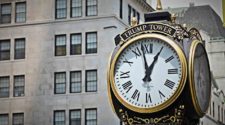Economists are having a tough conversation about the trade.
For decades, they’ve advocated a free flow of goods and services, based on the Econ 101 idea that countries produce whatever they have a comparative advantage in creating, boosting overall welfare. But in the face of populist backlash and skyrocketing inequality, academics and policy makers are grappling with the reality that globalization has come with potentially destabilizing distributional consequences. The topic took center stage at the weekend’s gathering of central banking’s top brass in Jackson Hole, Wyoming.
This week’s economic research wrap includes important work on trade and earnings distributions. We start by looking at how trade impacts welfare, move on to mobility trends in the U.S., and finish with links to a few Jackson Hole presentations. In between, we summarize studies on job matching and the housing crisis. Check this column each week for new and interesting research from around the world.
How trade reshuffles the decks
Researchers are taking a stab at quantifying one of the hottest questions in economics right now: how much do winners win and losers lose in the case of a trade shock?
The welfare gap is big, BI Norwegian Business School’s Simon Galle, U.S. Census Bureau’s Moises Yi an the University of California at Berkeley’s Andres Rodriguez-Clare find, looking at changes in manufacturing employment and average earnings across geographies and education levels. While China’s rise has increased average welfare in the U.S., a small group representing a little less than 7 percent of the population experienced losses as high as five times the average gain. Those effects were regionally concentrated in places like southern Appalachia.
Slicing the Pie: Quantifying the Aggregate and Distributional Effects of Trade
Published August 2017
Available on the NBER website
Race and mobility
While we’re talking about distributional outcomes: this study is a big deal. Researchers use tax data for a massive U.S. population set over a long time span (2000 to 2014) to track trends in income mobility and inequality across a broad swath of race and ethnic groups. The main findings:
- The richest are pulling ahead across racial groups, but inequality is worsening between middle-income and poor whites while it stays stable or declines slightly for other groups. That’s happening as whites at the very bottom of the income ladder see their earnings fall.
- Don’t take that as good news for minorities. Poor blacks still make a lot less than poor whites. In fact, blacks, Hispanics and American Indians cluster at the bottom end of the earnings scale.
- Income mobility decreased for all races and ethnic groups over the study period. Rich whites and Asians dominate the higher rungs, and they increasingly stay put. Blacks, Hispanics and American Indians may move within their own subgroups, but they’re just shuffling around on the bottom of the overall earnings ladder.
“These details belie key beliefs within the U.S. that a person can ‘get ahead’ regardless of race and ethnic origin,” write the authors, who are from the Census Bureau and the University of California, Los Angeles.
Race Matters: Income Shares, Income Inequality, and Income Mobility for All U.S. Races
Published August 2017
Available at the NBER website
Job matching: the good news
During the Great Recession and subsequent recovery, employers have seen positions go unfilled even as potential workers stayed on the sidelines. It’s led many to speculate that there’s been a structural shift in the economy that’s caused a breakdown in job-search effectiveness, but the San Francisco Fed rebuts that theory.
Based on a new economic letter by economists Andreas Hornstein and Marianna Kudlyak, older workers and the disabled are less likely to easily match into jobs, and they make up a bigger share of today’s out-of-labor market adults. Once you account for that, matching efficiency looks more normal.

How Much Has Job Matching Efficiency Declined?
Published Aug. 28
Available on the San Francisco Fed website
Did we get the housing crisis wrong?
Yes, if you ask University of Pittsburgh researcher Stefania Albanesi and her co-authors. The popular narrative says that a pop in lending to poorly-qualified borrowers led to widespread default that was then magnified throughout the financial system. Albanesi and crew say that story is off: credit file data suggests that credit growth between 2001 and 2007 was concentrated among prime borrowers, and debt to high-risk folks was basically constant. The rise in defaults actually concentrated among people in the middle of the credit-score distribution.
So why did these higher-score people default? “The rise in mortgage delinquencies is virtually exclusively accounted for by real estate investors,” according to the working paper.
Credit Growth and the Financial Crisis: A New Narrative
Published August 2017
Available on the NBER website
Worth reading:
- My colleague Matthew Boesler summarizes a study that questions the Phillips Curve
- Fed Chair Janet Yellen defends the usefulness of post-financial crisis reforms
- Nina Pavcnik’s Jackson Hole symposium paper points out that trade liberalization creates winners and losers in developing countries, too







